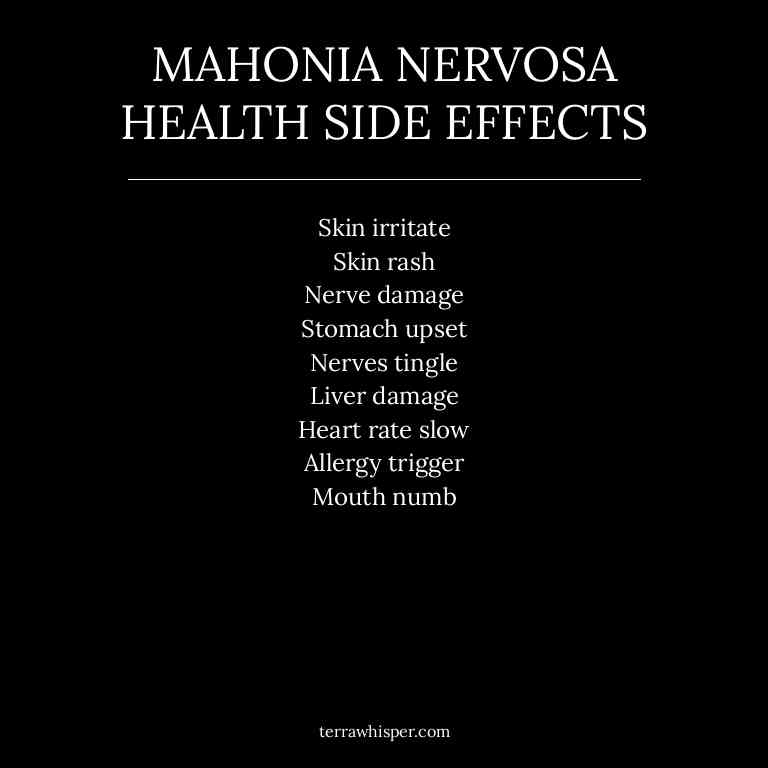Mahonia Nervosa Uses, Benefits, And Remedies

Mahonia nervosa, commonly known as the evergreen holly or Oregon grape, is a shrub native to the Pacific Northwest of the United States, known for its ornamental value and medicinal properties.
This herb is valued for its anti-inflammatory, antimicrobial, and antioxidant properties, which contribute to its use in traditional medicine.
The bioactive constituents include berberine, protoberberine alkaloids, and flavonoids, which are responsible for its therapeutic actions.
Herbal preparations such as infusions, tinctures, and topical applications can be made from its leaves and berries to harness its health benefits.
This page analize the most important medicinal aspects of Mahonia nervosa.
- Health Benefits
- Bioactive Constituents
- Medicinal Parts
- Herbal Preparations
- Side Effects of mahonia nervosa
Health Benefits
Mahonia nervosa eases digestive issues due to its high concentration of alkaloids and tannins, which help reduce inflammation in the gastrointestinal tract and promote healthy digestion by stimulating the production of digestive enzymes.
It treats skin conditions because of its antimicrobial and anti-inflammatory properties, which help soothe irritations, reduce redness, and prevent infections in the skin. Mahonia nervosa kills bacterial infections due to the presence of berberine, a compound known for its broad-spectrum antimicrobial activity that inhibits the growth of harmful bacteria. It supports the immune system by enhancing the body's natural defenses through its antioxidant and anti-inflammatory compounds, which help neutralize free radicals and reduce oxidative stress.
It reduces joint pain because of its anti-inflammatory and analgesic properties, which help alleviate inflammation and discomfort associated with conditions like arthritis.
The 10 best health benefits of Mahonia nervosa are shown in the image below.

The list below give a brief description of the 10 best health benefits of Mahonia nervosa.
- Eases Digestive Issues: Mahonia nervosa herb helps alleviate digestive discomfort by promoting healthy digestion and reducing bloating and gas.
- Treats Skin Conditions: The herb is known to soothe various skin conditions such as eczema and psoriasis due to its anti-inflammatory and antimicrobial properties.
- Kills Bacterial Infections: Mahonia nervosa contains compounds that exhibit antibacterial effects, helping to combat bacterial infections effectively.
- Supports Immune System: This herb boosts the immune system by enhancing the body's natural defenses against pathogens and infections.
- Reduces Joint Pain: The anti-inflammatory properties of Mahonia nervosa help reduce joint pain and swelling associated with arthritis and other inflammatory conditions.
- Treats Gastrointestinal Issues: It aids in treating gastrointestinal issues by improving gut health and reducing inflammation in the digestive tract.
- Reduces Inflammation Fast: Mahonia nervosa is effective in rapidly reducing inflammation, making it useful for managing conditions like inflammation and pain.
- Soothes Respiratory Issues: The herb can help soothe respiratory issues such as coughs and bronchitis by reducing inflammation and mucus production.
- Aids In Detoxification: Mahonia nervosa supports the body's detoxification processes by promoting the elimination of toxins through the liver and kidneys.
Bioactive Constituents
Mahonia nervosa oleuropein, a bioactive compound found in the Mahonia nervosa herb, has been studied for its potential health benefits, including antioxidant and anti-inflammatory properties.
Oleuropein is known to support cardiovascular health by reducing oxidative stress and improving endothelial function. In addition to oleuropein, Mahonia nervosa contains quercetin, a flavonoid with strong antioxidant and anti-inflammatory effects that may help in reducing the risk of chronic diseases.
Isorhapontigenin, another constituent of this herb, has demonstrated potential in inhibiting cancer cell growth and modulating immune responses. Berberine, a well-known alkaloid, is also present in Mahonia nervosa and is recognized for its antimicrobial, anti-diabetic, and cardioprotective properties.
Together, these compounds contribute to the therapeutic potential of Mahonia nervosa, making it a valuable herbal resource for various health applications.
The 13 best bioactive constituents of Mahonia nervosa are shown in the image below.

The list below give a brief description of the 10 best bioactive constituents of Mahonia nervosa.
- Oleuropein: A polyphenolic compound known for its antioxidant and anti-inflammatory properties, commonly found in olive leaves and some medicinal plants.
- Quercetin: A flavonoid with strong antioxidant and anti-inflammatory effects, known to support immune function and cardiovascular health.
- Isorhapontigenin: A flavonoid glycoside with potential anti-inflammatory and antiviral properties, often studied for its therapeutic benefits.
- Berberine: An alkaloid with antimicrobial, anti-inflammatory, and antioxidant properties, used traditionally in herbal medicine for various health conditions.
- Oleanolic Acid: A triterpenoid compound with anti-inflammatory, antiviral, and hepatoprotective properties.
- Ursolic Acid: A pentacyclic triterpenoid known for its anti-inflammatory, antimicrobial, and anticancer properties.
- Lupool: A compound with potential antimicrobial and anti-inflammatory effects, though less commonly studied compared to other constituents.
- Bergapten: A furocoumarin compound that exhibits phototoxic properties and has been studied for its antimicrobial and anti-inflammatory effects.
- Palmitic Acid: A saturated fatty acid involved in energy storage and cellular processes, though typically considered a neutral compound in medicinal contexts.
- Stearic Acid: A long-chain saturated fatty acid that is generally neutral in medicinal properties but plays a role in lipid metabolism.
- Linoleic Acid: An essential omega-6 fatty acid involved in cell membrane structure and signaling, with potential anti-inflammatory properties.
- Arachidic Acid: A long-chain saturated fatty acid that is primarily involved in energy storage and has minimal direct medicinal activity.
- Astragalin: A flavonoid glycoside with potential antioxidant and anti-inflammatory properties, often found in various medicinal plants.
Medicinal Parts
Mahonia nervosa leaf has been traditionally used in herbal medicine for its various therapeutic properties, including its ability to act as a mild laxative and to treat skin conditions such as eczema and psoriasis.
The leaves contain compounds like berberine, which is known for its antimicrobial and anti-inflammatory effects, making them useful in treating infections and reducing inflammation. Additionally, the leaves are often used in topical applications to soothe irritated skin and reduce itching.
In some traditional practices, the leaves are also employed to alleviate symptoms of digestive disorders and to support overall gastrointestinal health. The fruit of Mahonia nervosa, while less commonly used, is also valued for its potential medicinal benefits, including its high content of flavonoids and other antioxidants that may contribute to its anti-inflammatory and immune-boosting properties. However, the fruit is typically harvested in late summer and is often used in small quantities due to its strong flavor and potency.
Both the leaf and fruit of Mahonia nervosa have been integral components in traditional herbal medicine, offering a range of health benefits when used appropriately.
Herbal Preparations
Mahonia nervosa teas are one of the most popular herbal preparations made from the plant, often used for their mild astringent and digestive properties.
To prepare the tea, the dried leaves or berries of Mahonia nervosa are steeped in hot water for several minutes, resulting in a slightly bitter and aromatic infusion. This preparation is commonly consumed to support digestive health and to alleviate symptoms of indigestion or bloating.
In addition to teas, decoctions of Mahonia nervosa are also used, where the plant material is boiled for a longer period to extract more potent compounds, making it suitable for addressing more severe digestive issues. Tinctures and syrups made from Mahonia nervosa offer concentrated forms of the herb, often used for their antimicrobial and astringent effects, particularly in traditional medicine practices. Capsules and mucillages derived from the plant provide convenient and standardized dosing options, allowing for easy integration into daily wellness routines.
These various preparations highlight the versatility of Mahonia nervosa in herbal medicine, offering multiple ways to harness its therapeutic benefits.
The 10 best herbal preparations of Mahonia nervosa are shown in the image below.

The list below give a brief description of the 10 best herbal preparations of Mahonia nervosa.
- Teas: Mahonia nervosa tea is commonly used to support digestive health and relieve mild gastrointestinal discomfort due to its mild astringent properties.
- Decoctions: Mahonia nervosa decoctions are valued for their potential to alleviate symptoms of inflammation and support urinary tract health due to their diuretic and anti-inflammatory effects.
- Tinctures: Mahonia nervosa tinctures are often used to promote bile production and support liver function, as well as to address skin irritations and fungal infections.
- Syrups: Mahonia nervosa syrups are traditionally used to soothe coughs and respiratory congestion, owing to their expectorant and antimicrobial properties.
- Mucillages: Mahonia nervosa mucillages are used to coat and protect the digestive tract, aiding in the relief of inflammation and irritation in the stomach and intestines.
- Capsules: Mahonia nervosa capsules provide a convenient form of the herb for supporting overall digestive health and immune function, with standardized potency for consistent results.
Side Effects of mahonia nervosa
Mahonia nervosa skin irritate can occur in individuals who are sensitive to the plant's compounds, leading to redness, itching, or a burning sensation upon contact with the skin.
This reaction is often due to the presence of alkaloids and other irritant substances found in the plant's leaves and berries. In more severe cases, Mahonia nervosa may cause skin rash, characterized by raised, inflamed patches that can be uncomfortable and persistent.
While less common, prolonged exposure may also lead to nerve damage, resulting in symptoms such as tingling or numbness in the mouth and extremities. Additionally, some users have reported gastrointestinal discomfort, including stomach upset, and in rare instances, the herb has been linked to liver damage or a slowed heart rate.
These side effects highlight the importance of consulting a healthcare professional before using Mahonia nervosa, especially for individuals with pre-existing medical conditions or allergies.
The 9 most common side effects of Mahonia nervosa are shown in the image below.

The list below give a brief description of the 9 most common side effects of Mahonia nervosa.
- Skin Irritate: May cause redness, itching, or inflammation of the skin due to an allergic reaction or sensitivity to the herb.
- Skin Rash: Can lead to a breakout of red, itchy, or bumpy skin lesions as a result of an adverse reaction to the herb.
- Nerve Damage: Prolonged use may result in damage to the nervous system, leading to numbness or tingling sensations.
- Stomach Upset: May cause nausea, vomiting, or diarrhea due to irritation of the gastrointestinal tract.
- Nerves Tingle: Can cause a tingling or prickling sensation in the extremities due to its effects on the nervous system.
- Liver Damage: Long-term use may lead to liver toxicity, impairing liver function and causing damage.
- Heart Rate Slow: May lead to bradycardia, or a slower than normal heart rate, affecting cardiac function.
- Allergy Trigger: May trigger allergic reactions in sensitive individuals, causing symptoms like hives or difficulty breathing.
- Mouth Numb: Can cause a numbing sensation in the mouth, lips, or tongue due to its effects on nerve endings.